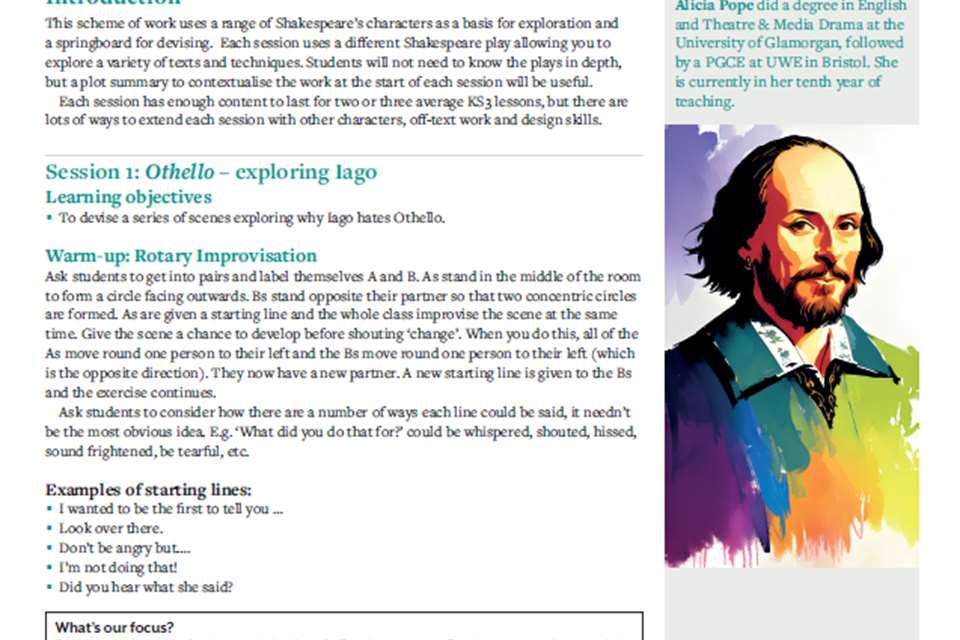Shakespeare's First Folio: A pioneering publication
Amelia Marriette
Monday, May 1, 2023
As we celebrate the 400th anniversary of Shakespeare’s First Folio this year,Amelia Marriette recognises the editors behind this pioneering publication and explains how she brought them to life in a new play.

Adobe Stock/ Elena Panevkina
This year marks the 400th anniversary of Shakespeare’s First Folio, the first complete works of Shakespeare published in 1623, seven years after his death. Both the theatrical and the literary world are celebrating this event throughout the year, with exhibitions, performances and new publications scheduled.
In 2001 I was a student at the Shakespeare Institute in Stratford-upon-Avon, reading for my MA in Shakespeare Studies. I was also working part-time for the Royal Shakespeare Company alongside a colleague, Prue, whose grandfather had acted in the very first season at the Shakespeare Memorial Theatre in 1879.
Finding inspiration in a postcard and a story
Prue was a constant inspiration and regaled me with tales of the theatre. After a visit to London, she returned with a postcard of the memorial that celebrates two men, John Heminges and Henry Condell, who were responsible for editing and bringing to life the First Folio. Why don’t we know more about the men who brought us one of the most important works of literature in the western world?
What the First Folio gives us
There are 36 plays in the First Folio, and without Heminges and Condell, 18 would have been lost, including Macbeth, Julius Caesar, The Tempest and Twelfth Night. The Folio gives us more polished and reliable versions of the plays, replacing ‘Bad’ Quarto Editions. It presents us with the plays as texts to be read as well as performed. The Folio elevated Shakespeare’s reputation, turning him from a lowly but very popular actor and playwright into the Bard. The famous Martin Droeshout engraving on the frontispiece of the First Folio offers us a definitive likeness of Shakespeare chosen people who knew him.
Dramatising the story
During this time working at the Shakespeare Institute, I also became a founding member of the Stratford Playwrights. We vowed to write a play in three months during a long, hot summer. I sat in the shed and started to write about Heminges and Condell.
Finding inspiration in the ‘cast’ who gave us the First Folio
I bought Peter Blayney’s book, The First Folio of Shakespeare, and suddenly I had all so many remarkable characters to write about who had been involved in the making of the First Folio. It wasn’t just Heminges and Condell, but also William Jaggard and Isaac Jaggard, the father and and son duo who printed and published the manuscript. The death of William Jaggard – a potential disaster for Heminges and Condell – was ripe for exploration in my work, as was the apprentice Leason, who doeseem to have been particularly adept.
I entered the completed play, titled Nay, Remember Me!, to the Royal Shakespeare Company’s Fringe Festival at the Other Place Theatre. I never intended to become a spokesperson for the First Folio. If my great friend Prue had not given me that postcard in 2001, I would never have fallen in love with the idea of this dusty old book. One of the most profoundly important parts of theatre is its role in bringing together people of all ages and all backgrounds to exchange stories and inspire one another. One of the reasons that Shakespeare is part of our DNA is because of the existence of the First Folio.
2023 is an important year for the Bard and presents an excellent opportunity to look afresh at Shakespeare on the page in order to illuminate the stage. We owe a debt of gratitude to Heminges and Condell, because 400 years later, Shakespeare’s First Folio is the gift that keeps on giving.
First Folio celebrations to look out for this year
The Shakespeare Birthplace Trust
The Shakespeare Birthplace Trust in Stratford-upon-Avon is home to three copies of the First Folio. Visit this year to see its new exhibition, featuring the original Ashburnam Folio, a seal ring bearing the initials ‘WS’ that is thought to have been worn by Shakespeare, and a small 17th-century notebook filled with quotations and notes belonging to one of the Bard’s earliest fans. Included in the exhibition ticket price is access to all three of Shakespeare’s family homes in the town.
Shakespeare’s Globe
Throughout the spring and summer months, the Globe will be hosting a series of walking tours on the theme of ‘Shakespeare’s printers and playscripts’. You’ll be taken around the Bankside area and across the River Thames into the historic St Paul’s to learn about the colourful history of printing in Britain. You’ll also find out more about banned books and ‘bad’ quartos.
Royal Shakespeare Company
The RSC in Stratford-upon-Avon is dedicating much of its 2023 Shakespeare season to plays that may have been lost without the publication of the First Folio, including Julius Caesar and Macbeth.
Shakespeare North Playhouse
Lauren Gunderson’s The Book of Will will make its European and UK premiere at Queen’s Theatre in Hornchurch, London, before heading north to Prescot for a run from 19 October-11 November. The play is set just a few years after Shakespeare’s death, when a pirated Hamlet rip-off lands on British stages. Shakespeare’s acting friends hatch a plan to right the wrongs and set the Bard’s words down on paper to create an accurate legacy of his works.
Malvern 400 Folio Festival
Five days of Folio-related talks, events and workshops this November, including five performances of Nay, Remember Me! by Amelia Marriette.
Teaching resources and classroom activities
The Folger Shakespeare Library in Washington DC has the largest collection of First Folios in the world.Visit folio400.com for everything you need to know about the 400th anniversary of the First Folio. It is a fantastic resource with information on the process of publication, the principal characters involved in it, and the contents within the Folio, with approximate dates of each play, route to print and a brief synopsis. You can also listen and follow as actors recite extracts from the plays.Lesson ideas from the TES: bit.ly/3ZILHCy. This comes with a range of PDF files and a free licence from the TES.
Conversation starters and creative workshop ideas
Research the main characters who brought the First Folio to life and write some dramatic scenes of your choosing.In my play Nay, Remember Me! I include John Heminges’s wife and Shakespeare’s wife, but not Henry Condell’s. Encourage your students to research Condell’s wife and write about her and one or more of the 23 children Heminges and Condell had between them.Get your students to dramatise a scene in which someone is trying to convince a reluctant customer to buy a copy of the First Folio.In Nay, Remember Me! I bring Shakespeare onto the stage as a ghost. Encourage your students to write a scene in which Shakespeare is having a conversation with someone in the afterlife.
The ‘Bad’ Q1 Quarto: a teaching exercise
Take a scene from one of the first printed plays by Shakespeare, known as the ‘Bad’ Q1 quartos. Choose from Hamlet, Henry V, The Merry Wives of Windsor or Romeo and Juliet and compare it with the same scene in the First Folio. Looking at all the changes: stage directions, changes in the language or even the punctuation. Encourage your students to perform or read the scenes aloud. Are there some good ideas in the ‘Bad’ Q1 quarto edition? You can extend this exercise to compare these scenes with the set texts that you usually use in the class of any of the above. Modern editors change the texts in ways that we are not always aware of.
The ‘Bad’ Q1 Quarto: some useful links using Hamlet as the key text
The Cambridge Guide to the Worlds of Shakespeare: Hamlet 3.1: ‘To be or not to be’: http://bit.ly/424mXGx
The British Library: Bad Quarto of Hamlet, 1603: http://bit.ly/3LlS8qS







